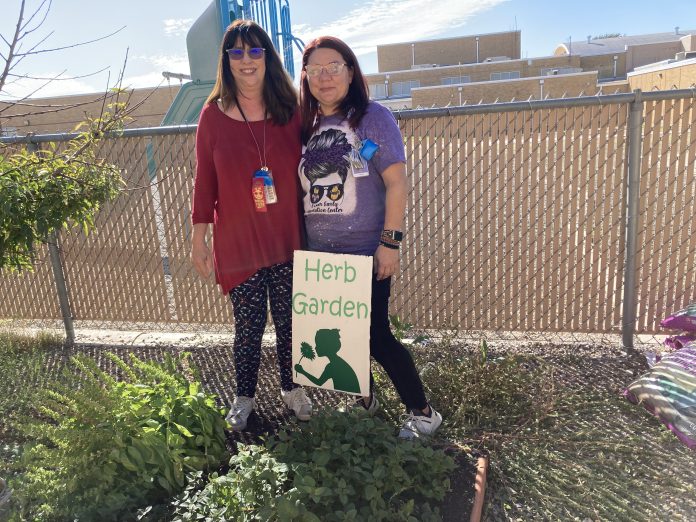
The team of D’on Paquette and Tatum Roe have been making things grow and creating excitement about insects and STEAM at Carver Early Education Center for many years.
Roe recently received a $1,000 grant from the Education Foundation for Insects and Metamorphosis! Watch me Grow.
Paquette received a $6,500 grant for STEAMing Our way Through Early Childhood and $500 for How Does Your Garden Grow. STEAM stands for science, technology, engineering, art and math.
Paquette has been awarded grants before, but Roe had not. Paquette has been with ECISD for 34 years with 17 at Carver.
Roe has been with the district for nine years — two years at Milam and seven at Carver.
Carver has mostly 4-year-old students, but there are 3-year-olds with special needs as well.
“I’ve done the garden one since 2017 and so it’s a recurring grant,” Paquette said. “And then Ms. Roe kind of piggybacked on it and extended it by doing the insects that we release … in the garden at the end of the unit.”
Roe said they have three different insects — ladybugs, caterpillars and ants.
“The ladybugs and the caterpillars, they get to watch them go through their stages from egg to adult,” Roe said.
They just watch the ants do their thing.
Roe said those bugs were selected because it’s easy for children to see how they change.
“Those are three of the major insects that we touch on in our theme for insects and critters. The ants, we talk about the body parts — the thorax, the head, the abdomen. We learned about those, so that covers our ants and helps that visual. … From our insects, we go into a theme called changes and that helps us with the metamorphosis,” Roe said.
Paquette added that “they’re really cool.”
The students like to check on the insects every day to see what they’re eating and how they’re growing.
Roe said they used campus money to get the habitats two years ago.
“We did it last year and then I wrote a grant this year to keep it going through a recurring grant. So we have all of the habitats. We just have to get our insects back in and new books to learn about them as we go to incorporate literacy,” Roe added.
Paquette said after they let the insects go, the students look for them.
“They find a lot of them,” Paquette added.
Roe noted that students also learn how to take care of something.
“They know we have to be gentle with them and insects are good. We need them; we don’t kill them,” Roe said.
Paquette said the students learn a lot from the beginning of the year to the end of the year.
“It’s a big growth year,” Paquette said. “From zero to 5 is huge in language development. And so that’s what we were super focused on is language development.”
After watching the insects and looking at the habitat, Roe said you can usually ask any child in the hallway how their ants are doing and what are their ladybugs doing.
For example, students tell the teachers they’re larva.
“They learn the vocabulary that goes with them. They’re in a cocoon … we have to wait. They’re learning the vocabulary that goes with it. They are learning that it’s a process and it’s a time,” Roe said.
They order the insects from Insect Lore. Roe said they arrive within a week and she and a helper deliver the insects to classrooms and talk about what the students are going to do and what they’re going to see.
“Some of our classrooms do have the manipulatives (like plastic caterpillars, eggs and the cocoon) to show the stages, but not all of them so that’s something we’ll work on, too,” Roe said.
The campus’ small garden had tomatoes, three kinds of peppers, squash, zucchini, cantaloupe, watermelon, honeydew, a grape vine, a peach tree, a lemon tree and an herb garden with peppermint, strawberry mint, lemon balm, sage and lavender.
“Because our kids are only here one year, most of them, they plant in the spring for the new kids that are coming. When the kids get here there’s just a huge garden and they get to harvest it. Then the next spring, they plant it for the next batch of kids. We also have a little area of wildflowers and we just had sunflowers everywhere that were gorgeous,” Paquette said.
STEAMing Our Way Through Early Childhood features educational Legos.
“Some of the Legos have letters on them to practice their letters, building their names, building words,” Paquette said.
“One of the sets is a train and it’s basic coding. It has different colors and each color tells the train something different to do, so they decide what they want the train to do and they lay that color down on the track to make the train either reverse or turn the light on or the horn,” Paquette said.
Roe said it will also make a sound like it’s going over water.
Paquette said she would definitely encourage other teachers to apply for Education Foundation grants.
“It’s very easy to get an education grant. The way they have it set up it’s not hard at all. We’ve gotten lots of great grants here at Carver and your school gets to keep the stuff forever, so it’s definitely worth it,” Paquette said.
Everything they do at Carver is hands-on and that’s why these grants are so important to them.



